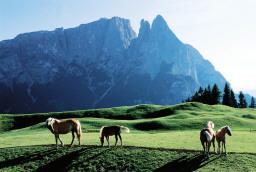Northern Italy's stunning Dolomite mountain range have moved closer to joining earth's other cultural and natural wonders on the United Nations World Heritage List.
The World Heritage Committee's technical advisory body on natural heritage, the International Union for the Conservation of Nature (IUCN), gave the area its seal of approval on Monday night.
Although the World Heritage Committee must still consider the application, the IUCN's endorsement is a critical step, said the local official who revealed the development on Tuesday.
Trentino Environment Councillor Mauro Gilmozzi said he had also received unofficial word that the World Heritage Committee would give its final verdict on this eastern stretch of the Alps on June 27.
The committee will meet in Seville from June 22 to 30 to consider applications from around the world.
In addition to the Dolomites, a central Italian waterfall called the Cascata delle Marmore is also hoping to join the 174 natural heritage sites already on the list.
The Italian mountaineer Reinhold Messner, considered one of the world's greatest climbers, last week explained why he was so excited about the campaign.
''I'm extremely supportive of the idea because I believe the Dolomites are completely unique - they cannot be compared to any other mountain in the world,'' said Reinhold Messner, who has been climbing in the Dolomites for six decades.
''Their beauty derives from the contrast between the green of the meadows and the vertical rock faces and the composition of the rock itself, which changes colour throughout the day.
''It also comes from the fact that each mountain in the range has its own unique, recognizable face and its own peculiar characteristics''.
Messner, now one of the leading voices of the World Heritage campaign, first suggested the idea in 1992 but it took another 10 years before it had enough political support to get off the ground.
The first application was made in December 2004, with backing from national and regional governments. In 2005, provincial authorities joined the campaign.
In September 2006, the IUCN launched its official investigation of the area but just 10 months later it recommended the World Heritage Committee put the application on hold.
The IUCN reportedly criticized a lack of coordination between the various provinces involved in the campaign and felt an overly large selection of mountain clusters had been nominated for the application.
Twenty-two groups of mountains were originally included in the application, based on four of the permitted World Heritage criteria for natural sites: exceptional natural beauty, significant ongoing geological processes, significant ongoing ecological and biological processes, and significant natural habitats for conservation of biological diversity.
Following the IUCN's conclusions, the number of Dolomite groups included in the application was reduced to nine, and the criteria were narrowed to natural beauty and geological processes.
The final candidate area, which has now received a green light from the IUCN, spans 142,000 hectares, with a further 85,000 border areas.
The Dolomites were formed around 90 million years ago, when the landmasses that are now Europe and Africa came together and pushed the Alps up out of the sea.
The reefs and coral that once surrounded lagoons, home to thousands of marine organisms, helped create the Dolomites' striking appearance and its unusual geological characteristics.
The unique formations were further shaped by glaciers that covered the earth during various ice ages and then melted as the world grew warmer again, carving out valleys and peaks.
The northern Italian range is today a haven for active holidaymakers, drawing climbers, hikers and skiers from around the world.
